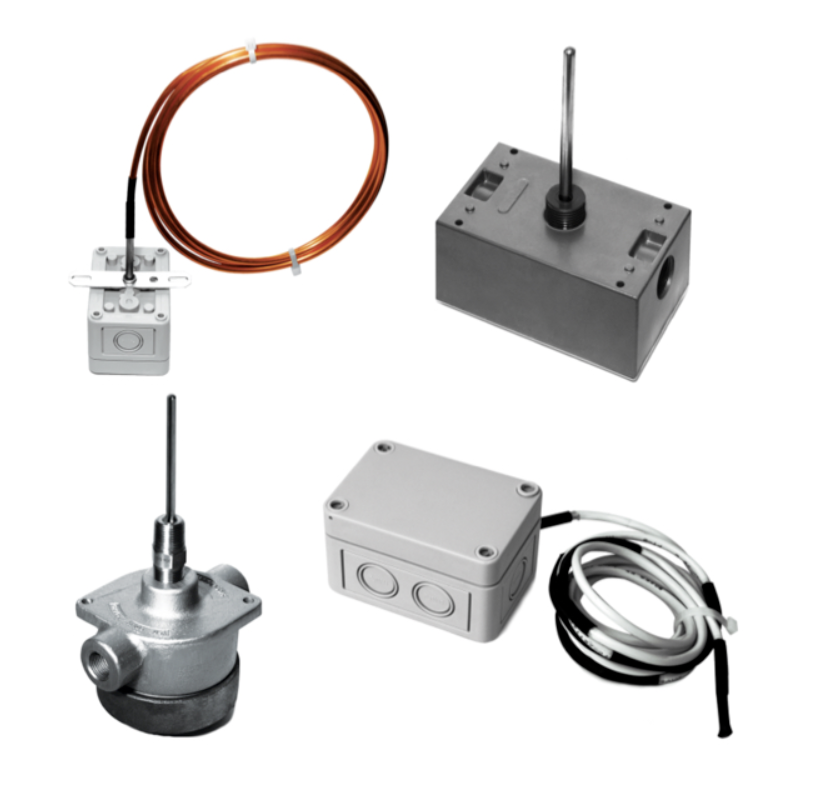Temperature Sensors & Transmitters

Temperature sensors and transmitters allow the monitoring, control, and even the measurement of temperature. At their most basic, these sensors and transmitters comprise two elements: a temperature-measuring device (the sensor part), which is the part that does the "sensing"; and a signal-processing component (the transmitter part), which converts the kind of signal generated by the "sensing" into a format that can be displayed or further processed.
Resistance temperature detectors (RTDs) and thermocouples are two of the most popular temperature-sensing technologies. As their name suggests, RTDs measure temperature by detecting changes in electrical resistance. In the case of an RTD that uses platinum, the resistance change is highly linear with temperature.
Taking a signal from a temperature sensor and converting it into a standardized output is the job of temperature transmitters. Transmitters can be used with either thermocouples or RTDs, but using them with RTDs seems to be becoming more common.
More Information about Temperature Sensors and Transmitters
Temperature sensors and transmitters are available in various types, depending on the application requirements. Some common types of temperature sensors and transmitters include:
Resistance Temperature Detectors (RTDs)
RTDs, also known as resistance thermometers, are temperature sensors that are made of a metal wire or film, and their resistance changes with temperature. RTD sensors are highly accurate and stable over a wide temperature range, making them suitable for use in industrial environments.
Thermocouples
Thermocouples are temperature sensors that use the voltage produced by two dissimilar metals to measure temperature. Thermocouples are highly durable and can withstand high temperatures, making them suitable for use in high-temperature industrial applications.
Infrared Temperature Sensors
Infrared temperature sensors use non-contact infrared technology to measure temperature. They are ideal for use in applications where the temperature needs to be measured without making contact with the object being measured, such as in food processing or medical applications.
Digital Temperature Sensors
Digital temperature sensors are microchip-based sensors that provide accurate temperature measurements and can communicate with digital systems.
FAQs
What is the difference between a temperature sensor and a temperature transmitter?
A temperature sensor is the sensing element that detects temperature and converts it into a raw electrical signal, such as resistance or voltage. A temperature transmitter conditions that signal and converts it into a standardized output such as 4–20 mA, 0–10 V, or a digital communication protocol. Transmitters allow accurate temperature data to be sent over long distances to PLCs, SCADA, and control systems used in industrial automation and process control.
What applications commonly use temperature sensors and transmitters?
Temperature sensors and transmitters are widely used in industrial manufacturing, HVAC systems, water and wastewater treatment, food and beverage processing, pharmaceuticals, chemical processing, oil and gas, and power generation. They provide continuous temperature monitoring for process control, safety protection, energy efficiency, and regulatory compliance. Accurate temperature measurement is essential wherever temperature affects product quality or system performance.
What types of temperature sensors are available?
Common temperature sensor types include thermocouples, resistance temperature detectors (RTDs), thermistors, and infrared temperature sensors. Each type offers different advantages in terms of temperature range, accuracy, response time, and environmental durability. Selecting the right sensor depends on operating temperature, required accuracy, media contact, and installation conditions.
How accurate are temperature sensors and transmitters?
Accuracy varies by sensor type and model, with many industrial temperature sensors and transmitters offering accuracy from ±0.1°C to ±1°C or better. Factors such as sensor quality, wiring, temperature gradients, environmental conditions, and calibration frequency can affect accuracy over time. Proper installation and routine calibration help maintain reliable and repeatable temperature measurements.
Do temperature sensors and transmitters require calibration and maintenance?
Yes, temperature sensors and transmitters should be periodically inspected and calibrated to ensure continued accuracy and dependable performance. Calibration intervals depend on application criticality and operating conditions. Regular maintenance helps detect sensor drift, wiring issues, or mechanical wear early, supporting system reliability and long-term measurement confidence.

